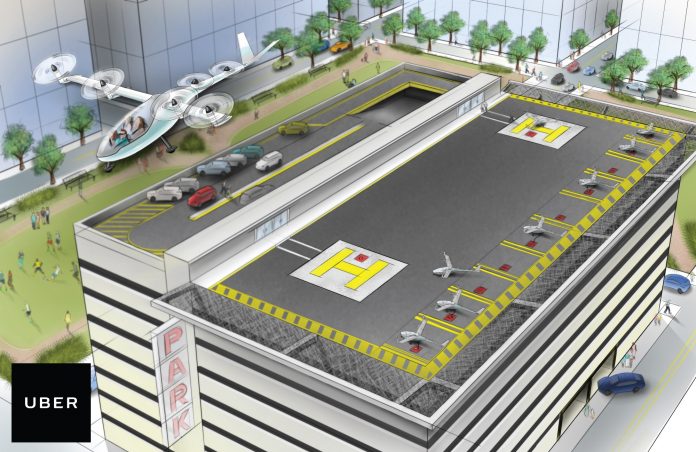Ride-sharing firm, Uber, has predicted a boom in personal aircraft, but not as they exist today. Instead, it sees optionally piloted electric aeroplane/helicopter hybrids as the future of general aviation.
The firm, known for its ride-sharing smartphone app, which in five years has disrupted the taxi industry worldwide, has explored the future of electric aircraft in a 98-page white paper, Elevate, released 27 October 2016.
Its vision is for vertical take-off and landing (VTOL) electric powered aircraft as the solution to urban traffic gridlock.
‘Just as skyscrapers allowed cities to use limited land more efficiently, urban air transportation will use three-dimensional airspace to alleviate transportation congestion on the ground,’ Uber chief product officer, Jeff Holden, writes in an introduction to the white paper.
The white paper says development of infrastructure to support an urban VTOL network is likely to have significant cost advantages over heavy infrastructure approaches such as roads, rail, bridges and tunnels.
Uber’s vision does not rely on airports. ‘It has been proposed that the repurposed tops of parking garages, existing helipads, and even unused land surrounding highway interchanges could form the basis of an extensive, distributed network of “vertiports” (VTOL hubs with multiple take-off and landing pads, as well as charging infrastructure) or single-aircraft “vertistops” (a single VTOL pad with minimal infrastructure).’
‘We also believe that in the long-term, VTOLs will be an affordable form of daily transportation for the masses, even less expensive than owning a car,’ the white paper says. A stringent but achievable safety target would be to have a fatal accident rate half of that for privately driven cars, or one quarter the present US Part 135 (commercial passenger-carrying small aircraft) fatality rate.
The document describes and argues for electric VTOL aircraft in great detail, noting their fundamental advantages in noise generation, simplicity of construction, compatibility with renewable energy and ease of piloting due to their inherently automated design.
‘In theory, pilot augmentation technology will significantly reduce pilot skill requirements, and this could lead to a commensurate reduction in training time,’ the white paper says.
It goes on to say: ‘Simpler, quieter and more operationally efficient vehicle designs are proposed which leverage digital control rather than mechanical complexity.’
Uber says a 200km range would be sufficient for urban commuting aircraft, and argues Part 135 alternate requirements requiring 40-minute diversion times are inappropriate given a VTOL’s ability to land almost anywhere.
However, Uber is not going into the aerospace business. ‘Rather than manufacture VTOL hardware ourselves, we instead look to collaborate with vehicle developers, regulators, city and national governments, and other community stakeholders, while bringing to the table a very fertile market of excited consumers and a clear vehicle and operations use case.’
VTOL manufacturers mentioned in the paper include Joby Aviation, Airbus’s A3 laboratory and e-volo, all of which have been reported on by Flight Safety Australia.



High winds, thunderstorms and heavy rain may not have factored in.
Think I will take the train!
I would be very concerned about safety.
What is “general aviation” if this scenario were to be seen as its future? Surely it is not merely to be measured by the greatest number of people who happen to be making short hops all about the place, even if that were truly feasible as a scenario. The article is facile in more ways than one beyond its implicit misrepresentation of what “general aviation” should mean. Uber surely has a hidden agenda that results in such glossy insincerity as that which drives such unctuous presentation.
Any automatic pilot system built into this form of aerial transport will have to be very sophisticated indeed. A proliferation of aerial vehicles traveling in three dimensions over a crowded city will need to have well thought out safety safeguards, not only for the passengers, but also for the general public below. How this can be achieved remains to be seen.
I think we have seen the potential for catastrophic accidents with over-reliance on digital automation in airliners flown by professional pilots, so I would be wary of relying on ‘leveraging digital control over mechanical complexity’. At the end of the day, it is still an aircraft, and you need to be able to pilot it safely.